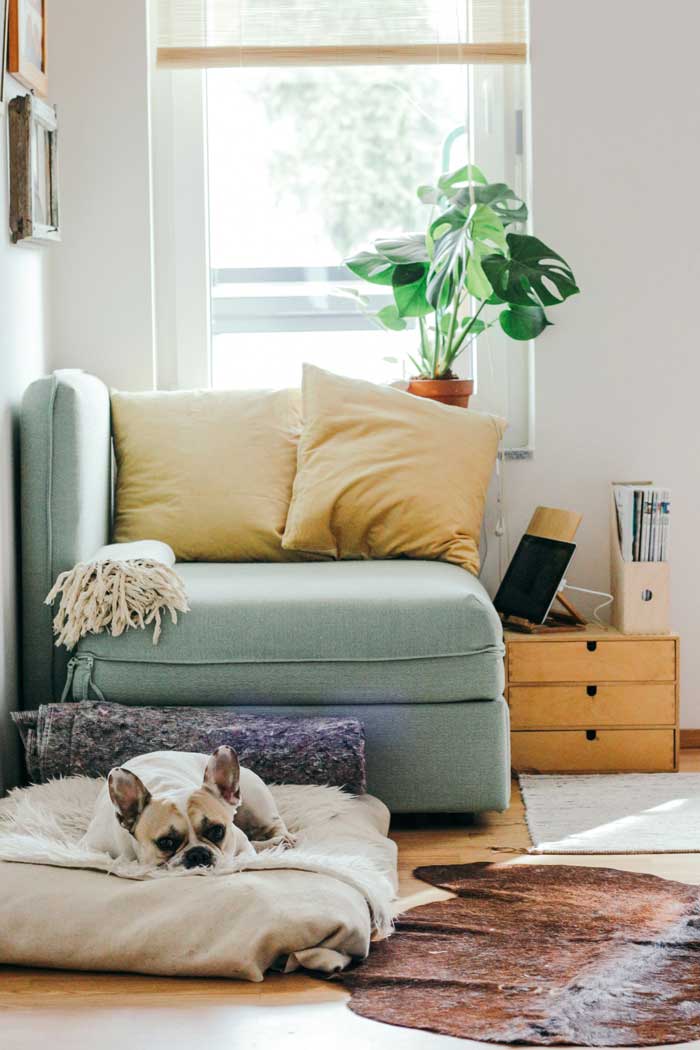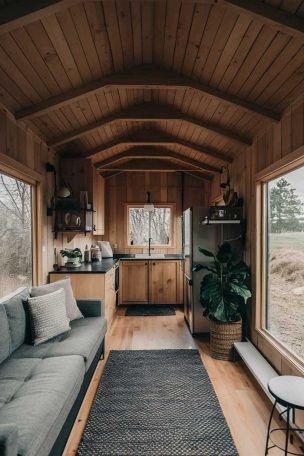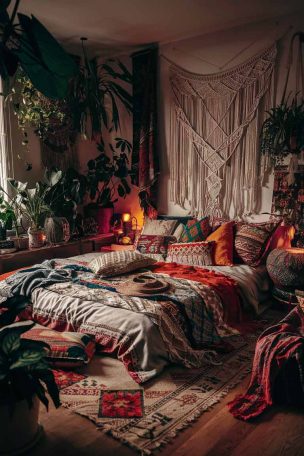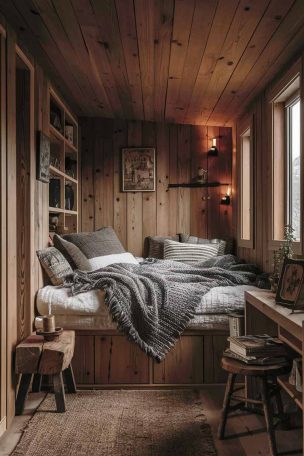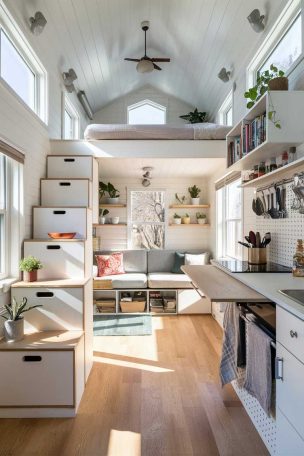Living in a tiny house is already a unique challenge, but add a furry friend to the mix, and you’ve got quite the adventure on your hands! Don’t worry, though.
With clever design choices and creativity, you and your pup can thrive in your compact abode. Let’s explore the world of tiny house living with dogs and how to make it work for everyone involved.
Designing a Dog-Friendly Tiny House
When it comes to creating a dog-friendly tiny house, every inch counts. The key is to think smart and get creative with your space. Let’s break it down:
Optimizing Space
First things first, you’ll need to designate specific pet zones. This isn’t just about giving your dog a place to sleep – it’s about creating a home within a home for your four-legged friend. Consider setting aside a cozy corner for your pup’s bed and toys. This gives them a sense of ownership and helps keep the rest of your space clutter-free.
One clever idea is to build feeding stations right into your kitchen area. Pull-out drawers or built-in nooks for food and water bowls can save floor space and prevent spills. Trust me, you’ll appreciate this when you’re not tripping over bowls in your tiny kitchen!
Don’t forget to think vertically, too. Wall-mounted perches or shelves can give your dog a place to lounge without taking up precious floor space. If you’ve got a cat, they’ll love having high spots to survey their kingdom.
Multipurpose furniture is your best friend in a tiny house. Look for pieces that can serve double duty, like a sofa with a hidden pet bed underneath or a coffee table with built-in storage for pet supplies. These smart solutions allow you to accommodate your pet without sacrificing your own living space.
Storage is always at a premium in tiny houses, so get creative! Hidden compartments for toys and gear, fold-away feeding stations, and built-in pet beds within furniture can help keep everything tidy and organized.
Choosing Pet-Friendly Materials
When it comes to materials, think durable and easy to clean. Non-toxic paints and finishes are a must – remember, your dog will be in close contact with every surface in your tiny home.
For flooring, opt for scratch-resistant options like bamboo or cork. These materials can stand up to your dog’s claws while still looking great. If you prefer something even more durable, consider laminate or tile. They’re a breeze to clean, which is crucial in a small space where messes can quickly become overwhelming.
Don’t forget about your furniture! Removable, washable covers are a lifesaver. They allow you to keep your seating areas fresh and clean, even with a dog in the house.
Creating Cozy Retreats
Every dog needs a place to call their own, even in a tiny house. Consider designing a cozy nook under the stairs or beside your bed. This gives your pup a den-like space where they can retreat when they need some quiet time.
If possible, position these areas near windows. Dogs love to watch the world go by, and giving them a view can provide hours of entertainment.
Lastly, don’t forget about outdoor access. If your tiny house design allows for it, installing a pet door can give your dog the freedom to come and go as they please. This can be especially helpful if you have a secure outdoor area for them to enjoy.
Managing Daily Life in a Tiny House with Dogs
Living in a tiny house with a dog isn’t just about the design – it’s also about how you manage day-to-day life. Here are some strategies to keep things running smoothly:
Establishing Routines
Consistency is key when living in a small space with a dog. Establish regular schedules for feeding, walks, and playtime. This helps your dog know what to expect and can prevent anxiety or destructive behavior.
It’s also helpful to designate specific areas for different activities. Maybe the area near the front door is for putting on leashes and wiping muddy paws, while a corner of the living space is for quiet playtime with toys.
Maintaining Cleanliness
Let’s face it – dogs can be messy. In a tiny house, staying on top of cleaning is crucial. Develop a daily routine of vacuuming floors and wiping down surfaces. It might seem like a lot, but in a small space, it doesn’t take long and makes a huge difference.
Regular grooming can also help minimize shedding and keep your space cleaner. Brush your dog often, and consider bathing them outside if possible to avoid clogging up your tiny house plumbing.
For odor control, air purifiers can be a great investment. You might also want to try pet-safe essential oils for a natural freshening solution.
Providing Mental and Physical Stimulation
A bored dog can quickly become a destructive dog, especially in a small space. Make sure your pup gets plenty of mental and physical exercise. Puzzle toys and food dispensers can keep them occupied indoors, while regular outdoor adventures provide necessary physical activity.
Don’t forget about training sessions, too. These not only keep your dog’s mind active but also reinforce good behavior – something that’s extra important when living in close quarters.
Outdoor Considerations for Tiny House Dogs
While the interior of your tiny house is important, don’t overlook the outdoor space. It can be a game-changer for both you and your dog.
Creating a Secure Outdoor Space
First and foremost, you need to ensure your outdoor area is secure. Fencing options like welded wire, aluminum, or vinyl can create a safe space for your dog to roam. If you’re living with cats or small dogs, consider creating an enclosed “catio” space. This allows them to enjoy the outdoors safely.
Designing Pet-Friendly Outdoor Areas
Within your secure space, think about creating designated areas for different activities. A specific potty area with easy-to-clean surfaces can help keep the rest of your yard (and your tiny house) cleaner.
Don’t forget about shade and shelter. A small covered patio or awning gives your pet a place to relax outdoors, even in less-than-perfect weather.
Finally, add some enrichment features to keep your pet entertained. This could include scratching posts for cats, or tunnels and play equipment for dogs. The more fun your outdoor space is, the more time your pet will want to spend there – giving you a bit more breathing room inside your tiny house.
Choosing the Right Dog for Tiny House Living
If you’re planning to move into a tiny house and are considering getting a dog, it’s worth thinking carefully about which breed might be best suited to your new lifestyle.
Size Considerations
Generally speaking, smaller breeds tend to do better in tiny spaces. Breeds like Cavalier King Charles Spaniels, Bichon Frises, and French Bulldogs are often good choices. They don’t need as much space to move around and typically have lower exercise requirements.
That said, some medium-sized breeds can also adapt well to tiny living. Bulldogs, Poodles, and Chow Chows, for example, are often content with moderate daily exercise and tend to be relatively calm indoors.
Surprisingly, even some larger breeds can work in a tiny house setting. Mastiffs, Great Danes, and Greyhounds, despite their size, are often quite laid-back and don’t require extensive indoor space. The key is ensuring they get enough outdoor exercise.
Temperament Factors
Size isn’t everything, though. A dog’s temperament is just as important when considering tiny house living. Look for breeds known for calm, adaptable personalities. Dogs with lower exercise needs and minimal barking tendencies are often better suited to close-quarters living.
Remember, every dog is an individual. While breed characteristics can give you a general idea, it’s important to spend time with a dog before bringing them into your tiny home to ensure their personality is a good fit for your lifestyle.
Training Your Dog for Tiny House Living
Even if you choose a dog that’s well-suited to tiny living, some training will likely be necessary to help them adapt to the space.
Desensitization Techniques
Start by gradually introducing your dog to the small space. Let them explore at their own pace, using positive reinforcement to create good associations. Treat them for calm behavior in the space, and slowly increase the amount of time they spend there.
Teaching Essential Commands
Certain commands become extra important in a tiny house. “Settle” or “relax” cues can be invaluable when you need your dog to chill out in a small space. Crate training can also be helpful, giving your dog a safe space to retreat to when needed.
Providing Mental Stimulation
In a tiny house, keeping your dog mentally stimulated is crucial to preventing boredom and destructive behavior. Food puzzles and interactive toys can provide hours of entertainment. Scent work activities, like hiding treats for your dog to find, can also be a great way to engage their mind without taking up much space.
Regular training sessions serve double duty – they keep your dog’s mind active and reinforce good behavior. Even a few short sessions a day can make a big difference in your dog’s behavior and overall happiness in your tiny home.
Creating a Calming Environment
Living in a small space can sometimes be stressful for dogs, especially if they’re used to more room. Creating a calming environment can help ease this transition.
Using Sensory Elements
Scent can be a powerful tool for calming dogs. Consider using pet-safe essential oils like lavender or chamomile in a diffuser. Just be sure not to overdo it – remember, your dog’s sense of smell is much stronger than yours!
Sound can also help create a soothing atmosphere. Soft background music or nature sounds can help mask potentially stressful noises from outside and create a more relaxing environment for your pup.
For dogs prone to anxiety, pheromone diffusers can be helpful. These release calming scents that mimic the pheromones mother dogs produce to soothe their puppies.
Designing Quiet Spaces
Every dog needs a quiet place to retreat to when they’re feeling overwhelmed. In a tiny house, this might be a cozy corner with their bed, or even a space under a piece of furniture. The key is to make sure this area is in a low-traffic part of your house and feels safe and secure to your dog.
Anxiety Management Tools
For dogs that struggle with anxiety, there are additional tools you can use. Anxiety wraps or vests can provide a sense of security for some dogs. These work by applying gentle, constant pressure – similar to swaddling a baby.
Perhaps most importantly, establish and stick to predictable routines. Dogs thrive on consistency, and knowing what to expect can go a long way in reducing anxiety in a small space.
Integrating Dog Crates into Tiny House Design
Dog crates can be a challenge in tiny houses, but with some creative thinking, you can integrate them seamlessly into your design.
Built-In Crate Solutions
One popular option is to create a built-in crate space under the stairs. This utilizes an often-underused area and can be designed to match your staircase, making it a stylish addition to your tiny house.
You might also consider integrating a crate into a wall, perhaps in an existing closet or nook. With some clever carpentry, this can look like a natural part of your tiny house design.
You could replace a base cabinet in the kitchen with a custom-built crate. This would keep your dog close while you’re cooking without putting them underfoot.
Furniture-Style Crates
Another option is to use furniture-style crates that serve double duty. A side table or media console that doubles as a dog crate can be a great space-saving solution. You could also consider building a bench with a cozy dog space underneath – perfect for entryways or dining areas.
Vertical and Outdoor Crate Options
Think vertically! A sleep space in a loft area could work well for smaller dogs. For tiny houses on wheels, you might even consider a custom-built exterior crate mounted above the hitch. This keeps your dog safe during travel without taking up interior space.
Don’t forget about outdoor storage options, too. A small shed or storage box could house a collapsible crate and other large dog gear, keeping your tiny house clutter-free.
Conclusion
Living in a tiny house with a dog certainly comes with its challenges, but it’s far from impossible. With thoughtful design, creative solutions, and a good understanding of your dog’s needs, you can create a comfortable, happy home for both you and your furry friend.
Remember, the key to success is flexibility and adaptability. What works for one dog might not work for another, so be prepared to try different solutions until you find what works best for you and your pup.
At the end of the day, the close quarters of a tiny house can actually strengthen the bond between you and your dog. You’ll be spending lots of quality time together, and there’s something special about sharing such an intimate space with your four-legged companion.
So go ahead, embrace the adventure of tiny house living with your dog. With a little patience and a lot of love, you’ll find that even the smallest house has plenty of room for happiness.

